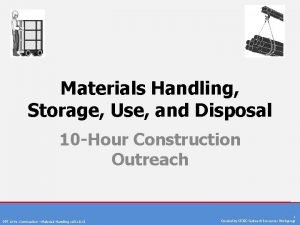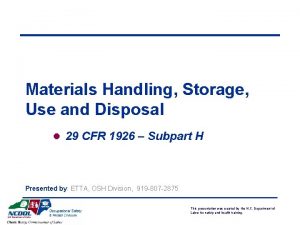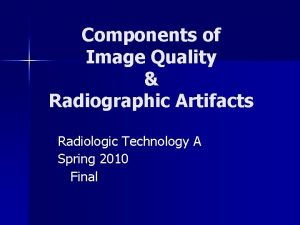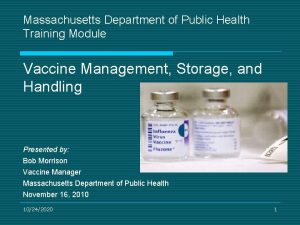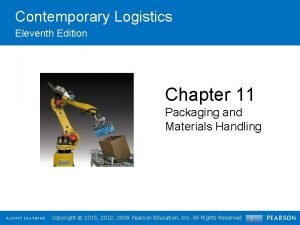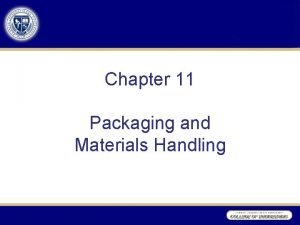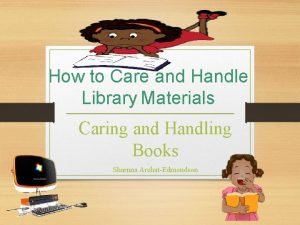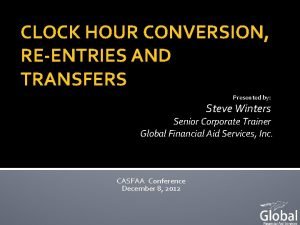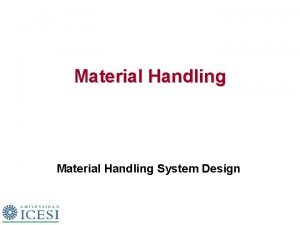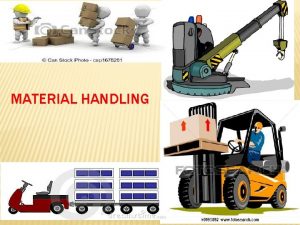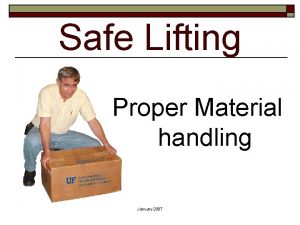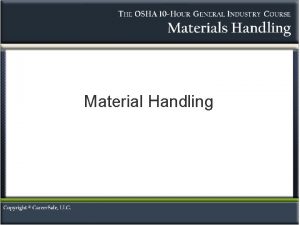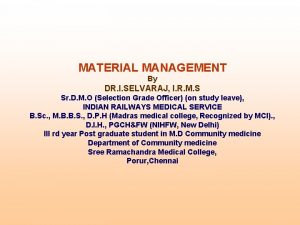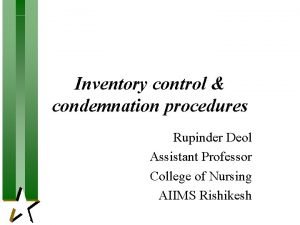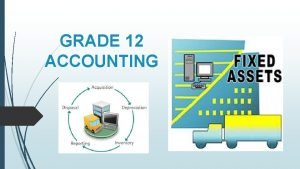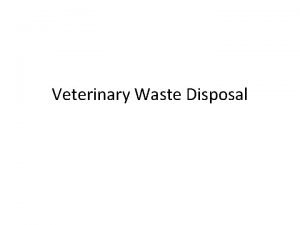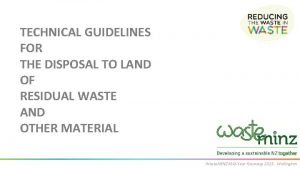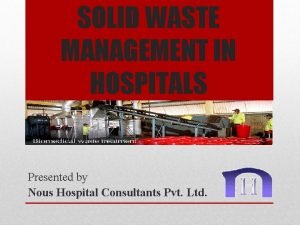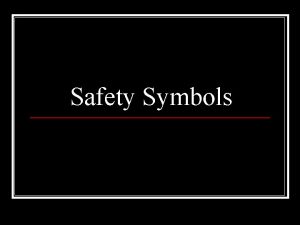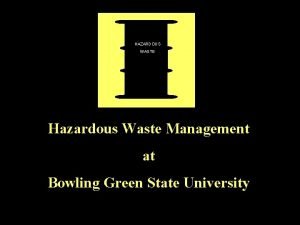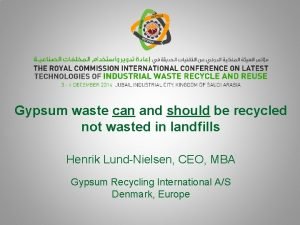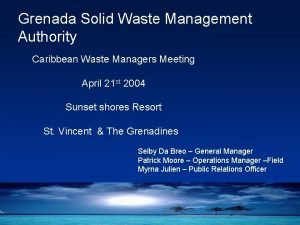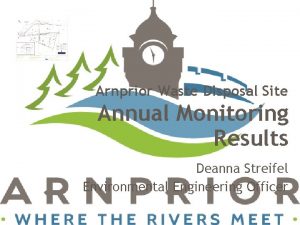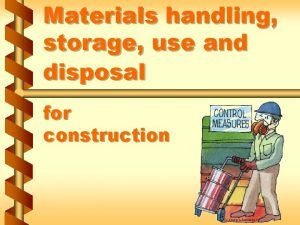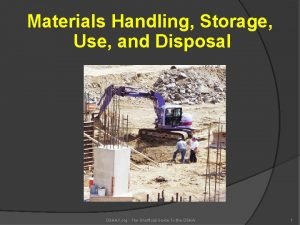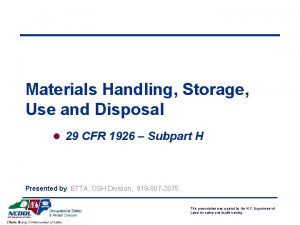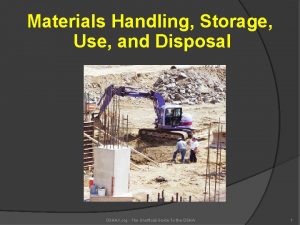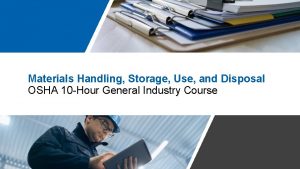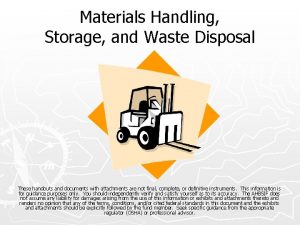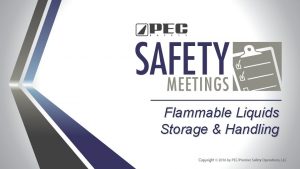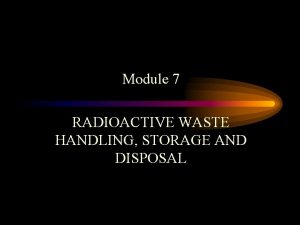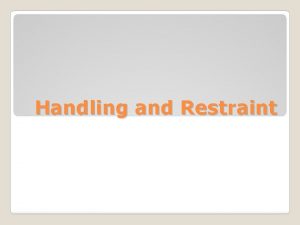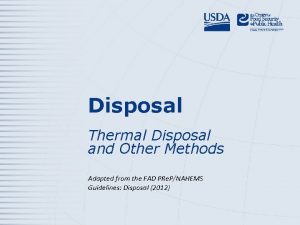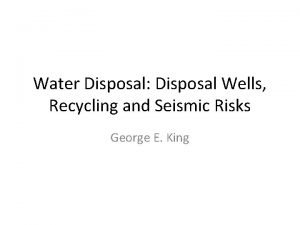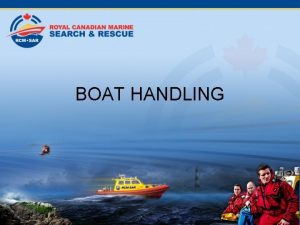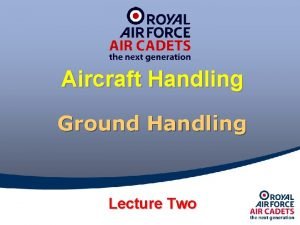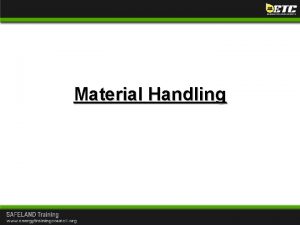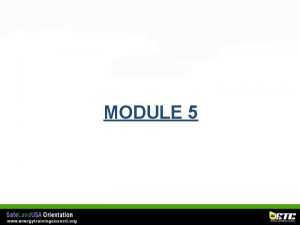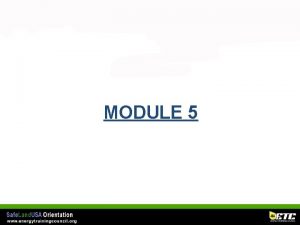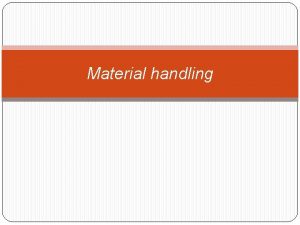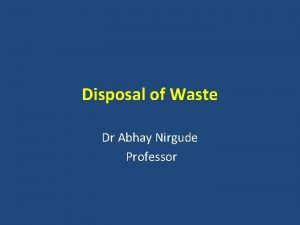Materials Handling Storage Use and Disposal 10 Hour










































- Slides: 42

Materials Handling, Storage, Use, and Disposal 10 -Hour Construction Outreach PPT 10 -hr. Construction – Materials Handling v. 05. 18. 15 1 Created by OTIEC Outreach Resources Workgroup

Materials Handling, Storage, Use, and Disposal • Lesson Overview – Types of material handling equipment. – Hazards associated with material handling activities – Prevention of hazards associated with material handling equipment – Employer requirements to protect workers from material handling hazards PPT 10 -hr. Construction – Materials Handling v. 05. 18. 15 2 Created by OTIEC Outreach Resources Workgroup

Types of Equipment Conveyors Source: OSHA PPT 10 -hr. Construction – Materials Handling v. 05. 18. 15 Powered Industrial Trucks Source: TEEX-Harwood 3 Created by OTIEC Outreach Resources Workgroup

Types of Equipment Cranes Slings Source: OSHA PPT 10 -hr. Construction – Materials Handling v. 05. 18. 15 4 Created by OTIEC Outreach Resources Workgroup

Factors Contributing to Injuries • Weight and bulkiness of objects • Bending, twisting, turning movements Source: OSHA PPT 10 -hr. Construction – Materials Handling v. 05. 18. 15 Source: OSHA 5 Created by OTIEC Outreach Resources Workgroup

Hazards • Improperation of equipment • Accumulated materials or clutter Source of photos: OSHA PPT 10 -hr. Construction – Materials Handling v. 05. 18. 15 6 Created by OTIEC Outreach Resources Workgroup

Hazards • Unsafe conditions of materials or containers • Flammability or toxicity of some materials Source: OSHA PPT 10 -hr. Construction – Materials Handling v. 05. 18. 15 7 Created by OTIEC Outreach Resources Workgroup

Hazards • Weight of materials • Binding ties or other devices that secure bundles or bound materials Source: OSHA PPT 10 -hr. Construction – Materials Handling v. 05. 18. 15 8 Created by OTIEC Outreach Resources Workgroup

Hazards • Falling objects • Lifting, pushing, pulling, or otherwise manually moving large, heavy items Source: OSHA PPT 10 -hr. Construction – Materials Handling v. 05. 18. 15 Source: OSHA 9 Created by OTIEC Outreach Resources Workgroup

Hazards • Improperly stacked materials • Struck-by or caught-in/-between hazards Source of photos: TEEX - Harwood PPT 10 -hr. Construction – Materials Handling v. 05. 18. 15 10 Created by OTIEC Outreach Resources Workgroup

Injuries • Types of injuries commonly reported – Sprains, strains, tears – Soreness and pain – Bruises and contusions – Cuts, lacerations, and punctures PPT 10 -hr. Construction – Materials Handling v. 05. 18. 15 Source: OSHA 11 Created by OTIEC Outreach Resources Workgroup

Injuries • Examples of events or exposures leading to injuries – Contact with objects and equipment Source: OSHA – Transportation incidents – Exposure to harmful substances or environments Source: OSHA PPT 10 -hr. Construction – Materials Handling v. 05. 18. 15 12 Created by OTIEC Outreach Resources Workgroup

Injuries – Falls, slips, trips, or loss of balance – Repetitive motion Source: OSHA – Overexertion Source: OSHA PPT 10 -hr. Construction – Materials Handling v. 05. 18. 15 13 Created by OTIEC Outreach Resources Workgroup

Preventing Hazards • Moving materials manually – Use devices to assist with holding loads – Wear PPE – Use proper lifting technique – Seek help for oversized loads – Use blocking materials PPT 10 -hr. Construction – Materials Handling v. 05. 18. 15 Source of photos: OSHA 14 Created by OTIEC Outreach Resources Workgroup

Preventing Hazards • Cranes – Major types of crane accidents • • Contact with power lines Overturns Falls Mechanical failure Source: OSHA PPT 10 -hr. Construction – Materials Handling v. 05. 18. 15 15 Created by OTIEC Outreach Resources Workgroup

Preventing Hazards – Hoisting tons of material, steel, and concrete with cranes – Operated only by thoroughly trained and competent workers Source: OSHA Source: TEEX - Harwood PPT 10 -hr. Construction – Materials Handling v. 05. 18. 15 16 Created by OTIEC Outreach Resources Workgroup

Preventing Hazards – Eliminate/reduce crane hazards by: • Knowing – Load – Capacity of the crane – When the load is safe to lift Source: TEEX - Harwood • Always checking crane load chart and never exceed load limits PPT 10 -hr. Construction – Materials Handling v. 05. 18. 15 17 Created by OTIEC Outreach Resources Workgroup

Preventing Hazards • Inspection of crane by a qualified person – – Modified, repaired, or adjusted Post-assembly At least every 12 months Equipment not in regular use • Visual inspection by a competent person – Prior to each shift – Monthly Source: OSHA PPT 10 -hr. Construction – Materials Handling v. 05. 18. 15 18 Created by OTIEC Outreach Resources Workgroup

Preventing Hazards • Slings – Connect a crane hook to a load – Proper selection – Inspection Source of photos: OSHA PPT 10 -hr. Construction – Materials Handling v. 05. 18. 15 19 Created by OTIEC Outreach Resources Workgroup

Preventing Hazards – Reduce sling hazards by: • Lubricated • Do not shorten with knots, bolts, or other devices, or kink legs • Keep clear of loads • Avoid sudden movement Source: OSHA PPT 10 -hr. Construction – Materials Handling v. 05. 18. 15 Source: OSHA 20 Created by OTIEC Outreach Resources Workgroup

Preventing Hazards • Forklifts – Main causes of injuries • • Forklift overturns Forklift striking workers on foot Persons crushed by forklifts Persons falling from forklifts Source: OSHA PPT 10 -hr. Construction – Materials Handling v. 05. 18. 15 21 Created by OTIEC Outreach Resources Workgroup

Preventing Hazards – Illegal forklift operators • Anyone under 18 • Anyone not properly trained and certified Source of photos: OSHA PPT 10 -hr. Construction – Materials Handling v. 05. 18. 15 22 Created by OTIEC Outreach Resources Workgroup

Preventing Hazards – Driving the forklift • • Obstructed vision Travel path Approaching people Elevated platform Seat belts and ROPS Raising/lowering forks Safe distance Source of photos: OSHA PPT 10 -hr. Construction – Materials Handling v. 05. 18. 15 23 Created by OTIEC Outreach Resources Workgroup

Preventing Hazards – Elevating workers with forklift • • Standing on forks Lifting personnel Approved lift platform Restraining means Source: OSHA PPT 10 -hr. Construction – Materials Handling v. 05. 18. 15 24 Created by OTIEC Outreach Resources Workgroup

Preventing Hazards – Driving forklift on Grades/Ramps • • Use extreme caution No turns Tilting and raising load Point load up the incline Source of photos: OSHA PPT 10 -hr. Construction – Materials Handling v. 05. 18. 15 25 Created by OTIEC Outreach Resources Workgroup

Preventing Hazards – Forklift operating speed • • • Tip-overs Turning Avoiding collisions Wet and slippery floors Ascending/descending Obstructed vision Source of photos: OSHA PPT 10 -hr. Construction – Materials Handling v. 05. 18. 15 26 Created by OTIEC Outreach Resources Workgroup

Preventing Hazards – Avoiding Excess Weight • Do not exceed weight capacity of forklift. • Center loads and secure to keep from shifting to maintain balance of weight Source: OSHA PPT 10 -hr. Construction – Materials Handling v. 05. 18. 15 27 Created by OTIEC Outreach Resources Workgroup

Preventing Hazards – Use of Dock Boards for Loading/Uploading • Bridging space • Securing portable dock boards • Handholds for dock boards Source: OSHA PPT 10 -hr. Construction – Materials Handling v. 05. 18. 15 28 Created by OTIEC Outreach Resources Workgroup

Preventing Hazards – Exiting the Forklift • Set brake, lower forks/lifting carriage, neutralize controls • Stand-up type forklift – Riding the forklift • No passengers allowed • Exception – seat is provided Source of photos: OSHA PPT 10 -hr. Construction – Materials Handling v. 05. 18. 15 29 Created by OTIEC Outreach Resources Workgroup

Preventing Hazards – Avoiding Struck-by/Crushed-by • Don’t jump from an overturning, sit-down type forklift. • Stay with the truck, hold on firmly, and lean in the opposite direction of the overturn. Source: OSHA PPT 10 -hr. Construction – Materials Handling v. 05. 18. 15 30 Created by OTIEC Outreach Resources Workgroup

Preventing Hazards – Forklift Training – do not operate a forklift without proper training and licensing. – Reporting Damage – any damage or problems that occur to a forklift during a shift should be reported to the supervisor. Source: OSHA PPT 10 -hr. Construction – Materials Handling v. 05. 18. 15 31 Created by OTIEC Outreach Resources Workgroup

Preventing Hazards • Earth-Moving Equipment – Scrapers – Loaders – Crawlers – Bulldozers – Off-highway trucks – Graders – Tractors Source of photos: TEEX - Harwood PPT 10 -hr. Construction – Materials Handling v. 05. 18. 15 32 Created by OTIEC Outreach Resources Workgroup

Preventing Hazards • Earth-Moving Equipment – Seatbelts – Reverse gear not used unless that piece of equipment has: • Back-up signal alarm or • Signaler Source: OSHA – Operator properly trained PPT 10 -hr. Construction – Materials Handling v. 05. 18. 15 33 Created by OTIEC Outreach Resources Workgroup

Employer Requirements • Comply with OSHA standards related to materials handling, including: – Training requirements, including requirements forklift training. – Inspection requirements Source of photos: OSHA PPT 10 -hr. Construction – Materials Handling v. 05. 18. 15 34 Created by OTIEC Outreach Resources Workgroup

Employer Requirements • Comply with manufacturers’ requirements and recommendations for materials handling equipment. Source : OSHA PPT 10 -hr. Construction – Materials Handling v. 05. 18. 15 35 Created by OTIEC Outreach Resources Workgroup

Recognizing Hazards Identify potential hazards and possible solutions: Source of photos : OSHA PPT 10 -hr. Construction – Materials Handling v. 05. 18. 15 36 Created by OTIEC Outreach Resources Workgroup

Recognizing Hazards Identify potential hazards and possible solutions: Source: OSHA PPT 10 -hr. Construction – Materials Handling v. 05. 18. 15 Source: TEEX - Harwood 37 Created by OTIEC Outreach Resources Workgroup

Recognizing Hazards Identify potential hazards and possible solutions: Source of photos : TEEX Harwood PPT 10 -hr. Construction – Materials Handling v. 05. 18. 15 38 Created by OTIEC Outreach Resources Workgroup

Knowledge Check 1. How old do you have to be to operate a forklift, regardless of training? a. b. c. d. 16 18 21 25 b. You must be at least 18 years old to operate a forklift. PPT 10 -hr. Construction – Materials Handling v. 05. 18. 15 39 Created by OTIEC Outreach Resources Workgroup

Knowledge Check 2. One good way to prevent materials handling hazards is to ___. a. refuse to allow personnel to ride equipment without a seat and seatbelt b. report all damaged equipment immediately c. operate within manufacturer’s specifications d. All of these are good ways to prevent materials handling hazards. PPT 10 -hr. Construction – Materials Handling v. 05. 18. 15 40 Created by OTIEC Outreach Resources Workgroup

Knowledge Check 3. Which of the following is a method for eliminating or reducing crane operation hazards? a. Operators should know how much they are lifting as well as the rated capacity of the crane. b. A competent person should visually inspect the crane once a year. c. Never exceed the load limit by more than 10%. d. All of these. a. Crane operators should know how much they are lifting and the rated capacity of the crane. PPT 10 -hr. Construction – Materials Handling v. 05. 18. 15 41 Created by OTIEC Outreach Resources Workgroup

Knowledge Check 4. Employers must comply with OSHA standards related to materials handling, including training and _____. a. b. c. d. equipment operations inspection All of these. c. Employers must comply with OSHA standards for training and inspection. PPT 10 -hr. Construction – Materials Handling v. 05. 18. 15 42 Created by OTIEC Outreach Resources Workgroup
 A way to prevent materials handling hazards is to ___.
A way to prevent materials handling hazards is to ___. When disposal materials are dropped
When disposal materials are dropped Radiation fog artifact
Radiation fog artifact Vaccine storage and handling sop worksheet
Vaccine storage and handling sop worksheet Vaccine storage and handling protocol
Vaccine storage and handling protocol Protective packaging and materials handling
Protective packaging and materials handling Material handling objectives
Material handling objectives Use and care of the library
Use and care of the library 6 in 24 hour
6 in 24 hour Semester vs trimester
Semester vs trimester Primary storage and secondary storage
Primary storage and secondary storage Primary storage and secondary storage
Primary storage and secondary storage Unit load concept in material handling
Unit load concept in material handling Definition of materials handling
Definition of materials handling Proper handling of materials
Proper handling of materials Material handling introduction
Material handling introduction Proper handling and use of a microscope
Proper handling and use of a microscope Natural materials
Natural materials Are all materials useful
Are all materials useful Man made map
Man made map Adopting materials
Adopting materials Uses rigid metallic platters
Uses rigid metallic platters Object based and unified storage
Object based and unified storage Direct materials budget with multiple materials
Direct materials budget with multiple materials Retention and disposal of gmp documents
Retention and disposal of gmp documents Objective of material management
Objective of material management Condemnation in material management
Condemnation in material management Fixed asset note format
Fixed asset note format Introduction to storage
Introduction to storage It holds data instructions and information for future use
It holds data instructions and information for future use Lindsay waste disposal
Lindsay waste disposal Vet waste disposal
Vet waste disposal Technical guidelines for disposal to land
Technical guidelines for disposal to land Color coding for waste disposal
Color coding for waste disposal Open flame alert symbol
Open flame alert symbol Waste disposal lyndon
Waste disposal lyndon 3 waste disposal
3 waste disposal Dr neha agrawal
Dr neha agrawal Waste manifest
Waste manifest Disposal of gypsum waste
Disposal of gypsum waste Grenada garbage service
Grenada garbage service Anatomy of a garbage disposal
Anatomy of a garbage disposal Arnprior waste disposal site
Arnprior waste disposal site
